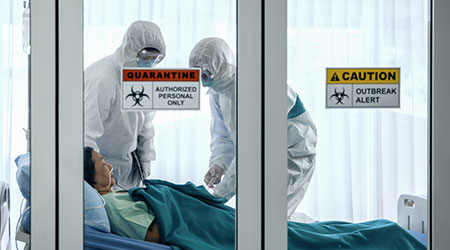The healthcare industry of today is not the industry we knew when 2020 started. The COVID pandemic has presented it with new and complex challenges, beginning with the suspension of nonessential medical procedures, hospitals’ main revenue source.
A new AHA report found that the financial repercussions of COVID on the healthcare sector will result in at least $323.1 billion in losses in 2020. Declines of 19.5% inpatient and 34.5% outpatient volumes combined with the rising costs of treating COVID patients have already exceeded the expected reimbursements from emergency government funding.
Hospitals must also contend with enormous volumes of electronic personal health information (ePHI) being shared over increasingly complex (and usually insecure) networks. The need to protect ePHI is paramount to protect patient privacy and to prevent reputational damage and further business losses. Add to that the increased costs of procuring unprecedented amounts of personal protective equipment (PPE) and the explosive rise in connected devices (20 billion today; 50 billion projected by 2028).
Hospitals are bleeding money and have no choice but to reduce expenses. The question is how?
Identify unnecessary expenses
Many clinicians stock up on devices to avoid shortages, but they fail to coordinate with departments like finance, facilities, IT, and biomed. This leads to a plethora of issues starting with duplicate purchases, underutilization of on-hand equipment, and the deployment of devices without any security measures. Each of these significantly drains financial resources and impacts the bottom line.
Cut corners
As healthcare organizations adapt to this new reality, CISOs and hospital boards are pushing for the adoption of innovative technologies and processes that provide quality and continuous services, maintain compliance, protect patient safety and data security, and cut down on unnecessary expenses. Many of these expenses accrue due to manually conducted processes and lack of visibility into device utilization and capacity, but can be easily avoided by employing automated solutions that not only cut down on costs but on time and manpower.
The labor hours required to manually discover, track, and take inventory of tens of thousands of assets across a healthcare organization can be cost prohibitive. Additional manpower is needed to conduct mandatory risk assessments and risk management programs to maintain regulatory compliance (penalties for noncompliance can range from $100 to $50,000 per medical record, with a maximum penalty of $1.5 million per year). With personnel already stretched to the limit, these essential projects often fall through the cracks even without a pandemic crisis.
Automated and AI-powered solutions can help healthcare organizations weather these challenges smoothly, can save money, increase affordability for patients, and potentially generate more revenue.
Take Back Control with Automated Tech
According to a study published by JAMA last October, “at least $760 billion per year,” or 25%, of healthcare spending is wasteful. But automated solutions can slash administrative expenses and solve the issues of duplicate purchases and underutilization of on-hand equipment, cut down on time and human resources spent procuring it. How?
They expedite projects - Automated asset management and inventory provides continuous visibility and helps save costs on double purchases and device replacements. Manual cybersecurity and risk assessment, replacement of outdated operating systems (OS), utilization monitoring, threat detection projects, and others can be cut down from weeks, months, or more to minutes and hours with automation tech.
They reduce required manpower - Labor has accounted for 54.9% of hospital expenses since 2018. Automation takes the pressure off administrative duties, expedites projects, and frees up staff for more critical tasks so they can focus on patients.
They safeguard against reputational and financial fallout from cyber attacks - According to a recent report, the average healthcare organization spent $1.4 million to recover from cyberattacks in 2019, and this estimate doesn’t include damages incurred from loss of business, productivity, or reputation. Automated and ongoing risk assessments enriched with clinical context ensure data confidentiality, reduce risk, and help hospitals quickly build and implement quality mitigation programs.
They cut procedural costs - Hospitals spend an estimated $93 billion a year on medical device management due to the "lack of accurate information, internal resources, bandwidth, and specialized expertise." Automated and predictive, or preventative, maintenance enables the prevention of device malfunctions and breakdowns while automated discovery and inventory help avoid unnecessary spending on procurement and device repairs.
They help ensure compliance - HIPAA compliance violations can cost hospitals anywhere from $100 to $50,000 per violation, with a maximum annual penalty of $1.5 million per violation. Continuous monitoring of ePHI activity and communications between in-network devices and external endpoints eliminates audit wait time and ensures data integrity. It also allows hospitals to be proactive, easily generate reports to avoid fines and pass audits while saving manpower with real-time alerts on policy violations.
It’s old news by now that the COVID pandemic has left an indelible mark on the global healthcare industry and forced it to restructure budgets, workflows, and the way patients receive care. It’s bled many hospitals’ coffers dry and stretched resources to unprecedented limits so that reducing expenses is now a necessity. But reducing expenses does not need to mean a decline in quality of care or an increase in healthcare-workplace stress levels.
The adoption of automation technologies designed for healthcare can streamline processes and avoid billions in unnecessary fiscal losses from double-spending on equipment, cyber attacks, labor costs, and audit fines. Most importantly, they can reduce the workload placed on healthcare professionals and help them focus on providing quality patient care.
Leon Lerman is CEO and Co-Founder of Cynerio.

 Building Sustainable Healthcare for an Aging Population
Building Sustainable Healthcare for an Aging Population Froedtert ThedaCare Announces Opening of ThedaCare Medical Center-Oshkosh
Froedtert ThedaCare Announces Opening of ThedaCare Medical Center-Oshkosh Touchmark Acquires The Hacienda at Georgetown Senior Living Facility
Touchmark Acquires The Hacienda at Georgetown Senior Living Facility Contaminants Under Foot: A Closer Look at Patient Room Floors
Contaminants Under Foot: A Closer Look at Patient Room Floors Power Outages Largely Driven by Extreme Weather Events
Power Outages Largely Driven by Extreme Weather Events